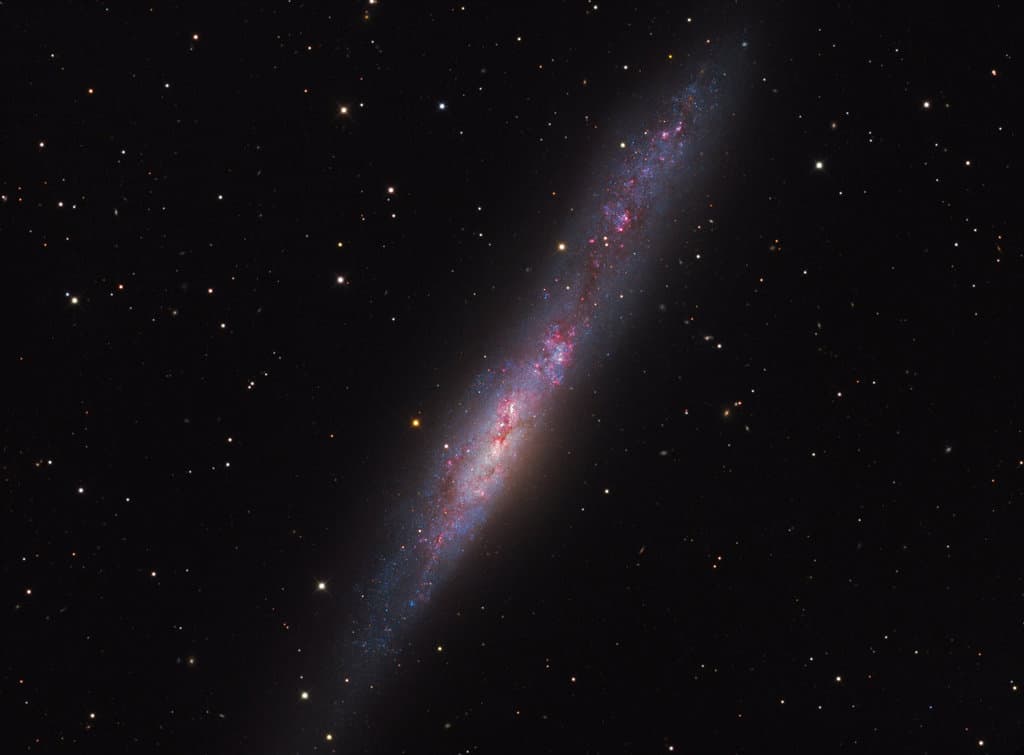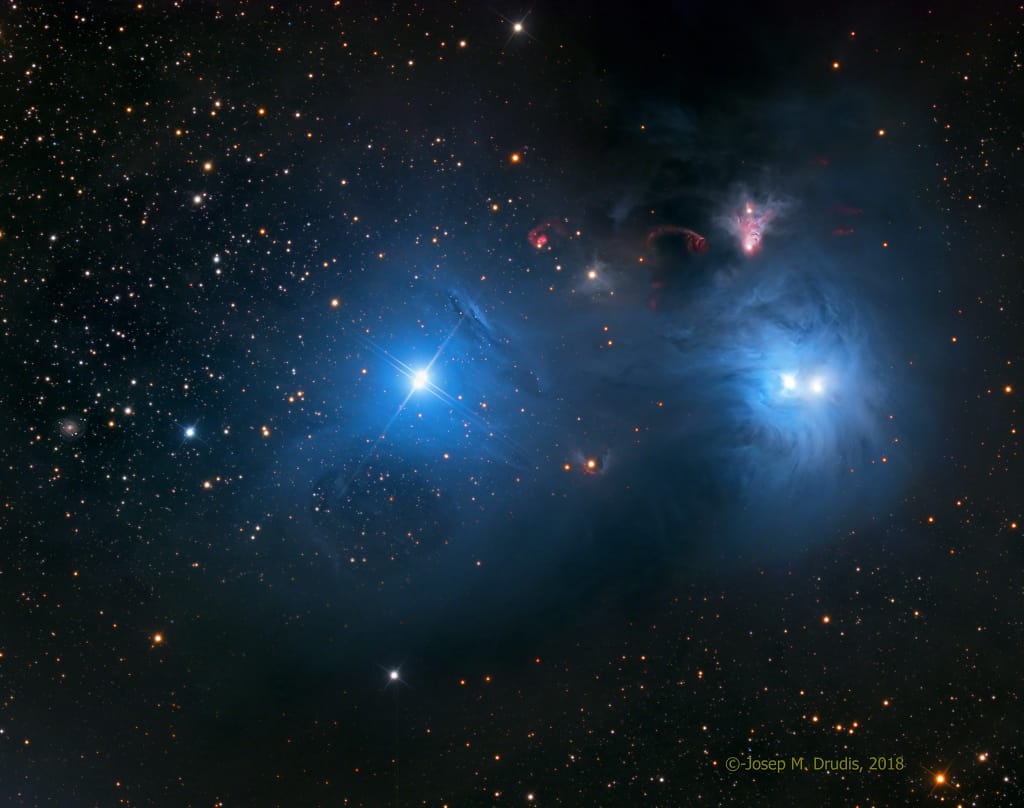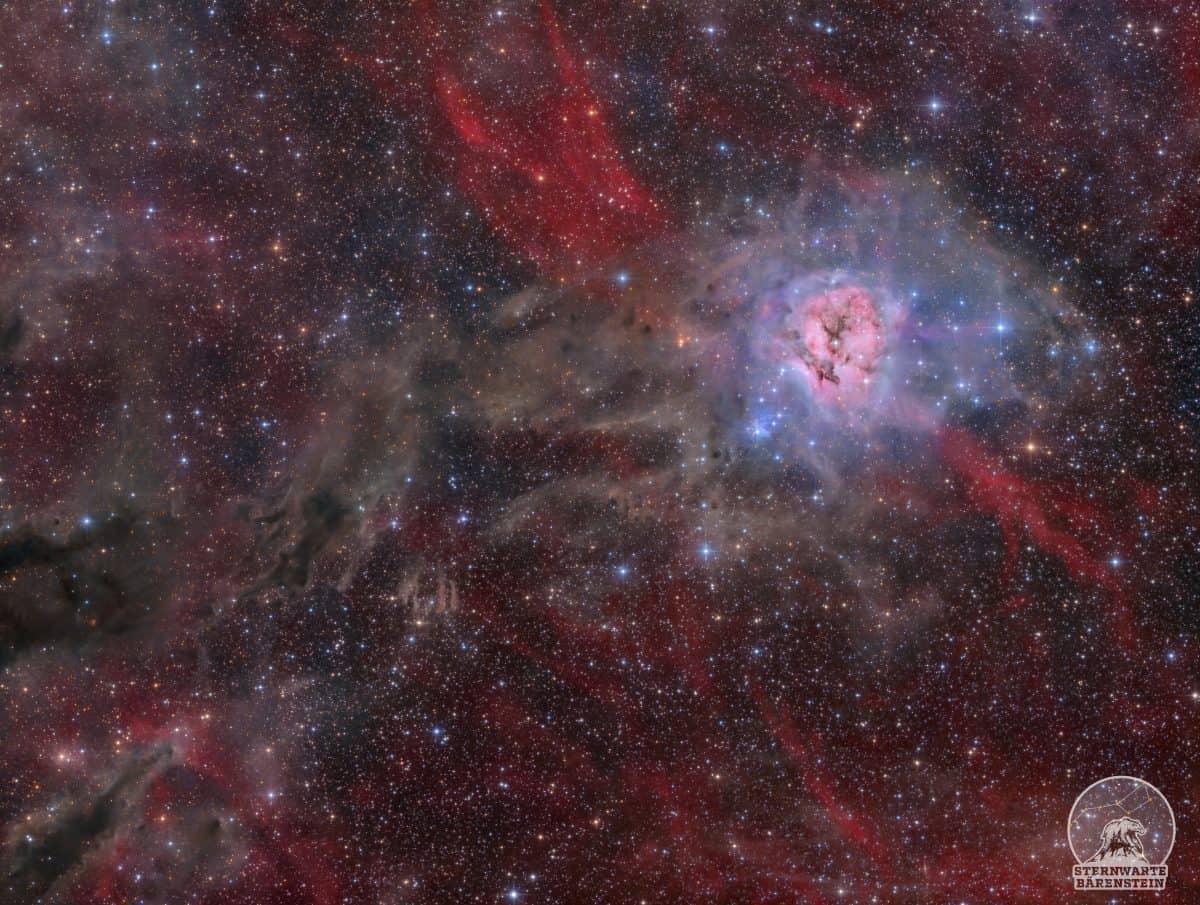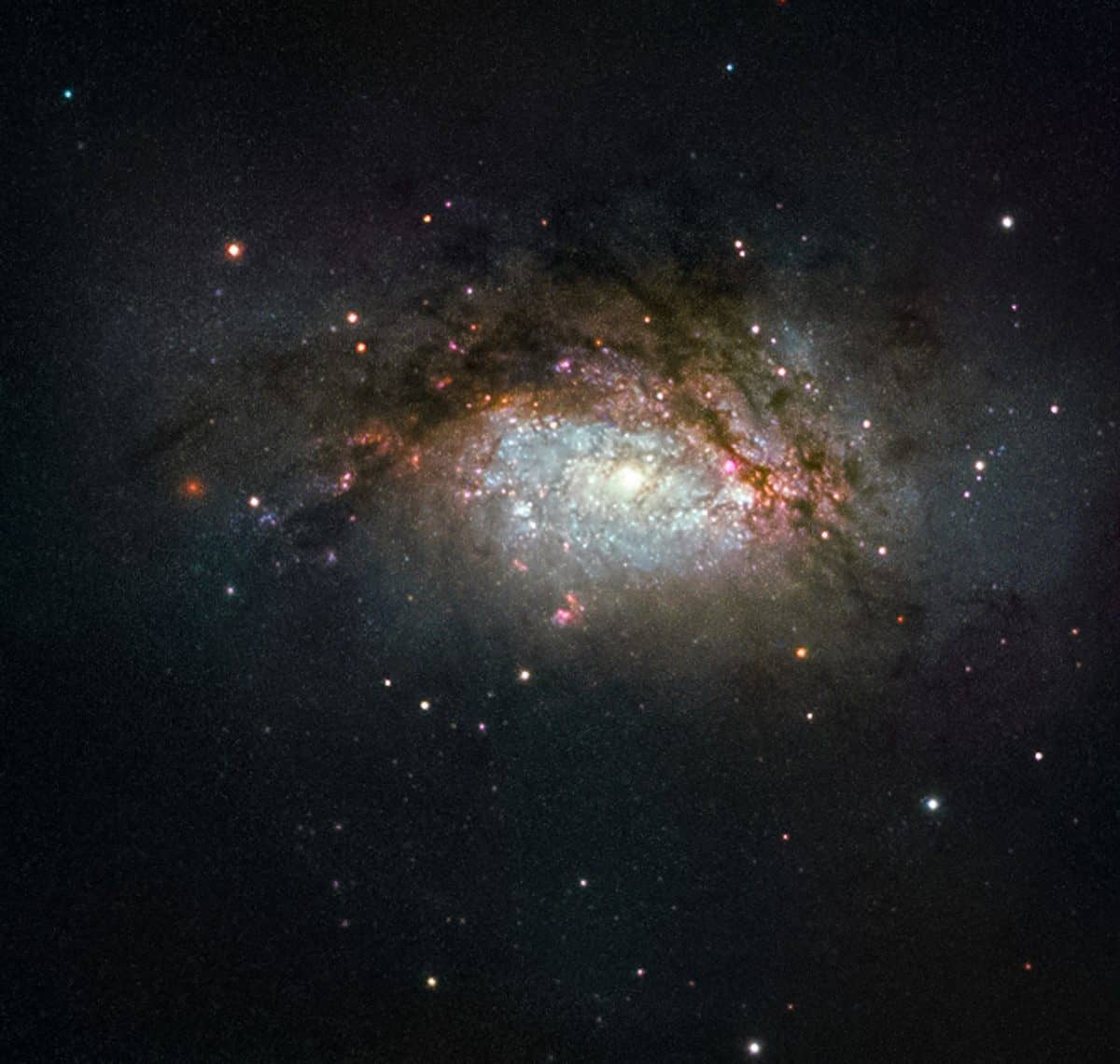Blog
Irregular galaxy NGC 55 is thought to be similar to the Large Magellanic Cloud (LMC). But while the LMC is about 180,000 light-years away and is a well known satellite of our own Milky Way Galaxy, NGC 55 is more like 6 million light-years distant and is a member of the Sculptor Galaxy Group. Classified as an irregular galaxy, in deep exposures the LMC itself resembles a barred disk galaxy. Spanning about 50,000 light-years, NGC 55 is seen nearly edge-on though, presenting a flattened, narrow profile in contrast with our face-on view of the LMC. Just as large star forming regions create emission nebulae in the LMC, NGC 55 is also seen to be producing new stars. This highly detailed galaxy portrait highlights a bright core crossed with dust clouds, telltale pinkish star forming regions, and young blue star clusters in NGC 55.
more...Leonard Norman Cohen CC GOQ (September 21, 1934 – November 7, 2016) was a Canadian singer-songwriter, poet and novelist. His work explored religion, politics, isolation, sexuality and personal relationships. Cohen was inducted into the Canadian Music Hall of Fame, the Canadian Songwriters Hall of Fame, and the Rock and Roll Hall of Fame. He was invested as a Companion of the Order of Canada, the nation’s highest civilian honour. In 2011, Cohen received one of the Prince of Asturias Awards for literature and the ninth Glenn Gould Prize.
Cohen pursued a career as a poet and novelist during the 1950s and early 1960s; he did not launch a music career until 1967, at the age of 33. His first album, Songs of Leonard Cohen (1967), was followed by three more albums of folk music: Songs from a Room (1969), Songs of Love and Hate(1971) and New Skin for the Old Ceremony (1974). His 1977 record Death of a Ladies’ Man was co-written and produced by Phil Spector, which was a move away from Cohen’s previous minimalist sound. In 1979, Cohen returned with the more traditional Recent Songs, which blended his acoustic style with jazz and Oriental and Mediterranean influences. Perhaps Cohen’s most famous song, “Hallelujah” was first released on his studio album Various Positions in 1984. I’m Your Man in 1988 marked Cohen’s turn to synthesized productions and remains his most popular album. In 1992, Cohen released its follow-up, The Future, which had dark lyrics and references to political and social unrest.
Cohen returned to music in 2001 with the release of Ten New Songs, which was a major hit in Canada and Europe. His eleventh album, Dear Heather, followed in 2004. Following a successful string of tours between 2008 and 2013, Cohen released three albums in the final four years of his life: Old Ideas (2012), Popular Problems (2014) and You Want It Darker (2016), the last of which was released three weeks before his death.
more...Foreststorn “Chico” Hamilton, (September 20, 1921 – November 25, 2013) was an American jazz drummer and bandleader.
He came to prominence as sideman with the likes of Lester Young, Gerry Mulligan, Count Basie and Lena Horne. Hamilton then struck out as a bandleader, first with a quintet featuring the cello as a lead instrument, an unusual choice for a jazz band in the 1950s, and subsequently leading a number of groups over the years that performed cool jazz, post bop and jazz fusion.
Foreststorn Hamilton was born in Los Angeles, California, one of three brothers. Another brother was actor Bernie Hamilton.
Hamilton started his career in a band with Charles Mingus, Illinois Jacquet, Ernie Royal, Dexter Gordon, Buddy Collette and Jack Kelso before he had finished high school. Engagements with Lionel Hampton, Slim & Slam, T-Bone Walker, Lester Young, Count Basie, Duke Ellington, Charlie Barnet, Billy Eckstine, Nat King Cole, Sammy Davis Jr., Billie Holiday, Gerry Mulligan and Lena Horne established his career.
Hamilton appeared in You’ll Never Get Rich (1941) as part of the backing group supporting Fred Astaire. Hamilton also performed on the soundtrack of the Bing Crosby and Bob Hope film Road to Bali (1952).
more...Charles Thomas “Tommy” Potter (September 21, 1918 – March 1, 1988) was a jazz double bass player, best known for having been a member of Charlie Parker‘s “classic quintet”, with Miles Davis, between 1947 and 1950.
Born in Philadelphia, Potter had first played with Parker in 1944, in Billy Eckstine‘s band with Dizzy Gillespie, Lucky Thompson and Art Blakey.[1]
Potter also performed and recorded with many other notable jazz musicians, including Earl Hines, Artie Shaw, Bud Powell, Count Basie, Sonny Rollins, Stan Getz, Max Roach, Eddie Heywood, Tyree Glenn, Harry “Sweets” Edison, Buck Clayton and Charles Lloyd.
more...World Music on Flamenco Fridays with Diego del More performing Ganania-Solea
Soleá is one of the flamenco palos with the highest number of traditional songs, and it is particularly appreciated by knowledgeable artists and audiences. It is very demanding for singers, as they have to strive to be creative and, at the same time, respectful of the tradition, and they have to succeed in finding a good balance between melodic and rhythmic sides, both extremely difficult. It demands great vocal faculties, and the singer should achieve a balance between passion and restraint.
The melody of a soleá stanza usually stays within a limited range (usually not more than a 5th). Its difficulty lies in the use of melisma and microtones, which demand great agility and precision in the voice. It is usual to start a series of soleares with a more restrained stanza in the low register, while continuing to more and more demanding ornaments in a higher register. The series is quite often finished with a stanza in a much more vivid tempo in the relative Major mode.
more...
Keith Moore “Red” Mitchell (September 20, 1927 – November 8, 1992), was an American jazz double-bassist, composer, lyricist, and poet.
Mitchell was born on September 20, 1927, in New York City. His younger brother, Whitey Mitchell, also became a jazz bassist.
Mitchell was raised in New Jersey by a father who was an engineer and loved music, and a mother who loved poetry. His first instruments were piano, alto saxophone, and clarinet. Although Cornell University awarded him an engineering scholarship, by 1947 he was in the US Army playing bass. The next year he was in a jazz trio in New York City.
Mitchell performed and/or recorded with Mundell Lowe, Chubby Jackson, Charlie Ventura, Woody Herman, Red Norvo, Gerry Mulligan, and, after joining the West Coast jazz scene in the early 1950s, with André Previn, Shelly Manne, Hampton Hawes, Billie Holiday, Stan Seltzer, Ornette Coleman, and others such as Mahalia Jackson. He also worked as a bassist in the TV and film studios around Los Angeles, occasionally appearing on screen. Mitchell also appeared in documentaries about Tal Farlow, and Zoot Sims.
https://www.youtube.com/watch?v=em-30f4jGjM
more...Cosmic dust clouds and young, energetic stars inhabit this telescopic vista, less than 500 light-years away toward the northern boundary of Corona Australis, the Southern Crown. The dust clouds effectively block light from more distant background stars in the Milky Way. But the striking complex of reflection nebulae cataloged as NGC 6726, 6727, and IC 4812 produce a characteristic color as blue light from the region’s young, hot stars is reflected by the cosmic dust. The dust also obscures from view stars still in the process of formation. At top right, smaller yellowish nebula NGC 6729 bends around young variable star R Coronae Australis. Near it, glowing arcs and loops shocked by outflows from embedded newborn stars are identified as Herbig-Haro objects. On the sky this field of view spans about 1 degree. That corresponds to almost 9 light-years at the estimated distance of the nearby star forming region.
more...Eric J. Gale (September 20, 1938 – May 25, 1994) was an American jazz and session guitarist.
Born in Brooklyn, New York, Gale began playing guitar at the age of 12. Although he majored in chemistry at Niagara University, Gale was determined to pursue a musical career, and began contributing to accompaniments for such stars as Maxine Brown, the Drifters, and Jesse Belvin. He soon began to attract the attention of King Curtis and Jimmy Smith, who began recommending him for studio work.[2] He became known first as a session musician in the 1960s, eventually appearing on an estimated 500 albums. Among the many artists he recorded with were Mose Allison, Aretha Franklin, Bob James, Paul Simon (Gale plays a supporting role in the 1980 film One-Trick Pony, written by and starring Simon), Lena Horne, Quincy Jones, Bob Marley, Nina Simone, Peter Tosh, Grover Washington, Jr., Herbie Mann, Esther Phillips, Joe Cocker, Carly Simon, Van Morrison, Al Jarreau, Dave Grusin, Lee “Scratch” Perry, Paul Douglas and Billy Joel. He also had played in Aretha Franklin’s stage band.
more...
Edwin Joseph Bocage (September 20, 1930 – March 18, 2009), known as Eddie Bo, was an American singer and pianist from New Orleans. Schooled in jazz, he was known for his blues, soul and funk recordings, compositions, productions and arrangements. He debuted on Ace Records in 1955 and released more single records than anyone else in New Orleans other than Fats Domino.
Eddie Bo worked and recorded for more than 40 different record labels, including Ace, Apollo Records, Arrow, At Last, Blue-Jay, Bo-Sound, Checker, Chess, Cinderella, Nola, Ric (for which business his carpentry skills were used to build a studio), Scram, Seven B, and Swan. He is described at Allmusic as “a sorely underappreciated veteran of the New Orleans R&B scene.”
Eddie Bo grew up in Algiers, Louisiana and in the Ninth Ward of New Orleans. He came from a long line of ship builders with the male members of his family being bricklayers, carpenters and masons by day and musicians by night. Eddie’s mother was a self-taught pianist in the style of friend, Professor Longhair. The Bocage family was involved in the traditional jazz community with cousins Charles, Henry and Peter, who played with Sidney Bechet, contributing to jazz orchestras before World War II.
more...Malta Folk Music
more...Accompanying Yom Kippur Service at Mt Zion Temple in St Paul Wednesday September 19th 2018 430pm
Yom Kippur, also known as the Day of Atonement, is the holiest day of the year in Judaism. Its central themes are atonement and repentance. Jewish people traditionally observe this holy day with an approximate 25-hour period of fasting and intensive prayer, often spending most of the day in synagogue services.
more...Inside the Cocoon Nebula is a newly developing cluster of stars. The cosmic Cocoon on the upper right also punctuates a long trail of obscuring interstellar dust clouds to its left. Cataloged as IC 5146, the beautiful nebula is nearly 15 light-years wide, located some 3,300 light years away toward the northern constellation of the Swan (Cygnus). Like other star forming regions, it stands out in red, glowing, hydrogen gasexcited by young, hot stars and blue, dust-reflected starlight at the edge of a nearly invisible molecular cloud. In fact, the bright star near the center of this nebula is likely only a few hundred thousand years old, powering the nebular glow as it slowly clears out a cavity in the molecular cloud‘s star forming dust and gas. This exceptionally deep color view of the Cocoon Nebula traces tantalizing features within and surrounding the dustystellar nursery.
(also Caldwell 19, Sh 2-125)
more...David Bromberg (born September 19, 1945) is an American multi-instrumentalist, singer, and songwriter. An eclectic artist, Bromberg plays bluegrass, blues, folk, jazz, country and western, and rock and roll. He is known for his quirky, humorous lyrics, and the ability to play rhythm and lead guitar at the same time.
Bromberg has played with many famous musicians, including Jerry Jeff Walker, Willie Nelson, Jorma Kaukonen, Jerry Garcia, Rusty Evans (The Deep) and Bob Dylan. He co-wrote the song “The Holdup” with former Beatle George Harrison, who played on Bromberg’s self-titled 1972 album. In 2008, he was nominated for a Grammy Award. Bromberg is known for his fingerpicking style that he learned from Reverend Gary Davis.
[arve url=”https://www.youtube.com/watch?v=hVG6-ZHiUbY” /]
George Lowen Coxhill (19 September 1932 – 10 July 2012),generally known as Lol Coxhill, was an English free improvising saxophonist and raconteur. He played the soprano or sopranino saxophone.
Coxhill was born to George Compton Coxhill and Mabel Margaret Coxhill (née Motton) at Portsmouth, Hampshire, UK. He grew up in Aylesbury, Buckinghamshire, and bought his first saxophone in 1947. After national service he became a busy semi-professional musician, touring US airbases with Denzil Bailey’s Afro-Cubists and the Graham Fleming Combo. In the 1960s he played with visiting American blues, soul and jazz musicians including Rufus Thomas, Mose Allison, Otis Spann, and Champion Jack Dupree.
more...Muhal Richard Abrams (born Richard Lewis Abrams; September 19, 1930 – October 29, 2017) was an American educator, administrator, composer, arranger, clarinetist, cellist, and jazz pianist in the free jazz medium. He recorded and toured the United States, Canada and Europe with his orchestra, sextet, quartet, duo and as a solo pianist. His musical affiliations is a “who’s who” of the jazz world, including Max Roach, Dexter Gordon, Eddie “Lockjaw” Davis, Art Farmer, Sonny Stitt, Anthony Braxton, and The Art Ensemble of Chicago.
Abrams’s mother, Edna, was born in Memphis. His father, Milton, was born in Alabama and moved with his parents to Chicago.
more...NGC 3597, also known as PGC 34266 and ESO 503-3, is a galaxy in the constellation Crater, approximately 147 million light-years away from us.
The subject of this NASA/ESA Hubble Space Telescope image is known as NGC 3597. It is the product of a collision between two good-sized galaxies, and is slowly evolving to become a giant elliptical galaxy. This type of galaxy has grown more and more common as the Universe has evolved, with initially small galaxies merging and progressively building up into larger galactic structures over time.
NGC 3597 is located approximately 150 million light-years away in the constellation of Crater (The Cup). Astronomers study NGC 3597 to learn more about how elliptical galaxies form — many ellipticals began their lives far earlier in the history of the Universe. Older ellipticals are nicknamed “red and dead” by astronomers because these bloated galaxies are not anymore producing new, bluer, stars in ages, and are thus packed full of old and redder stellar populations.
Before infirmity sets in, some freshly formed elliptical galaxies experience a final flush of youth, as is the case with NGC 3597. Galaxies smashing together pool their available gas and dust, triggering new rounds of star birth. Some of this material ends up in dense pockets initially called proto-globular clusters, dozens of which festoon NGC 3597. These pockets will go on to collapse and form fully-fledged globular clusters, large spheres that orbit the centres of galaxies like satellites, packed tightly full of millions of stars.
more...
More Posts
- Daily Roots with Prince Buster
- The Cosmos with R Aquarii
- Tomasz Stanko Day
- Clyde Bernhardt Day
- World Music with Diali Cissokho & Kaira Ba
- Daily Roots with Linval Thompson
- The Cosmos with NGC 3576
- Bela Fleck Day
- Lee Morgan Day
- Blind Boy Fuller Day
- World Music with Omar Bashir
- Daily Roots with Owen Gray
- The Cosmos with NGC 6300
- Mitch Mitchell Day
- Colin Bailey Day
- World Music with Combo Ginebra
- Daily Roots with Freddie McGregor
- The Cosmos with IRAS 23166+1655
- Jaimoe Day
- Louis Jordan Day



